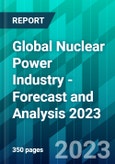The global nuclear power industry has been a significant player in the energy sector, providing a substantial portion of the world's electricity for several decades. Despite facing various challenges, it has remained a critical source of clean and reliable power. As of 2021, the worldwide nuclear power capacity stood at approximately 398 gigawatts (GW), supplied by 442 operating reactors across 30 countries.
In terms of market statistics, the Asia-Pacific region has emerged as a major hub for nuclear power, with countries like China, Japan, and South Korea leading the way. China, in particular, has significantly expanded its nuclear power capacity and continues to invest heavily in new projects. As of 2021, it had 50 operating reactors, with a total capacity of around 51 GW.
Europe also plays a significant role in the global nuclear power industry, with countries like France, Russia, and the United Kingdom being prominent players. France, known for its strong reliance on nuclear energy, boasts the highest share of nuclear power in its electricity generation mix. It operates 56 reactors, contributing to a capacity of approximately 63 GW. In North America, the United States has the highest number of operational reactors, standing at 93 with a capacity of approximately 98 GW. However, the country's nuclear industry has faced challenges in recent years, including competition from natural gas and renewable energy sources, leading to the closure of several older reactors. Nevertheless, the US continues to explore options for new nuclear projects, including advanced reactor designs.
The global nuclear power industry has witnessed both expansions and contractions in recent years. While some countries have embraced nuclear energy as a low-carbon solution to meet their electricity needs, others have scaled back or phased out their nuclear programs due to safety concerns and public opinion. Additionally, the industry faces challenges related to high construction costs, regulatory hurdles, and the safe disposal of radioactive waste.
The analyst presents a comprehensive research report titled "Global Nuclear Power Industry - Forecast and Analysis 2023," delving into a detailed examination of the worldwide nuclear power sector. The report commences with an extensive analysis of industry statistics, encompassing an industry overview, historical industry statistics, and industry segmentation. Notably, we investigate nuclear power's price trends, prevailing industry trends, the trajectory of nuclear power capacity expansion, additions of new capacity, and the public sentiment towards nuclear energy.
The study employs a robust analytical framework, including a SWOT analysis, Porter's Five Forces Strategy analysis, and a PEST analysis of the Global Nuclear Power Industry, thereby providing a well-rounded evaluation of the industry's competitive landscape and external influences. Furthermore, the report thoroughly examines the economics of nuclear power, incorporating capital costs, operational costs, system costs, and external costs. Additionally, a comparative analysis of the economic viability of nuclear power against other electricity generation methods is presented, alongside an assessment of investment incentives for nuclear power.
Recognizing the significance of climate change in the energy sector, the report investigates the global climate change implications and the impact of nuclear power in mitigating environmental concerns. Concurrently, it addresses the challenges and barriers that pose obstacles to the nuclear power industry.
Furthermore, a forward-looking perspective is provided, outlining the industry outlook until the years 2026 and 2030. This includes a comparative assessment of nuclear power against alternative power resources, enabling readers to make informed decisions in light of future energy demands.
Continuing our research, we conduct an in-depth analysis of key nuclear power markets worldwide, encompassing prominent regions such as Japan, China, India, the US, Ukraine, Russia, and more. Each market is subjected to a rigorous examination, providing valuable insights into its nuclear industry.
For every market, we present a comprehensive overview, covering nuclear capacity, fuel cycle details, and the regulatory framework governing the industry. Additionally, we delve into crucial aspects of nuclear waste management and nuclear non-proliferation, highlighting the responsible and secure handling of nuclear materials.
The markets analyzed include
- Argentina
- Armenia
- Brazil
- China
- Egypt
- France
- Germany
- India
- Iran
- Italy
- Japan
- Jordan
- Kazakhstan
- Kyrgyzstan
- Lithuania
- Mexico
- Namibia
- Nigeria
- North Korea
- Pakistan
- Romania
- Russia
- Saudi Arabia
- South Africa
- South Korea
- Taiwan
- Tajikistan
- Ukraine
- United Arab Emirates
- United Kingdom
- United States
- Uzbekistan
- Vietnam
These analyses serve as vital references for stakeholders and decision-makers seeking a comprehensive understanding of nuclear power dynamics in these regions.
Furthermore, we recognize the significance of industry players in shaping the global nuclear power landscape. To that end, we thoroughly analyze the leading entities in the Global Nuclear Power Industry, providing detailed business profiles, financial analyses, and comprehensive SWOT assessments. This includes a thorough evaluation of both nuclear power companies and nuclear power utilities, offering valuable perspectives on their respective strengths, weaknesses, opportunities, and potential threats. These findings offer invaluable insights for stakeholders seeking to make informed decisions and stay ahead in the evolving nuclear power sector.
Table of Contents
A. Executive Summary
Companies Mentioned
- Alstom SA
- Ameren Corporation
- American Electric Power Company
- Bharat Heavy Electrical Limited
- Cameco Corporation
- Centrais Eletricas Brasileiras SA (Eletrobras)
- China National Nuclear Corporation (CNNC)
- Chubu Electric Power Company (Chuden)
- Comision Federal de Electricidad (CFE)
- Dominion Energy
- Dongfang Electric Corporation
- Duke Energy Corporation
- E.ON SE
- EDF Electricité de France SA
- Electrabel SA
- Enbw Energie Baden Wuerttemberg AG
- Endesa SA
- Enel
- Energoatom
- Engie
- Entergy Corporation
- Eskom Holdings
- Exelon Corporation
- General Electric
- Hitachi
- Iberdrola SA
- Korea Electric Power Corporation (KEPCO)
- Mitsubishi Heavy Industries Ltd
- Nuclear Power Corporation of India Ltd (NPCIL)
- Nucleoelectrica Argentina
- Orano SA
- RWE AG
- Siemens AG
- State Grid Corporation of China
- Tokyo Electric Power Company Holdings (TEPCO)
- Toshiba
- Vattenfall








